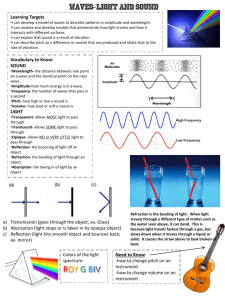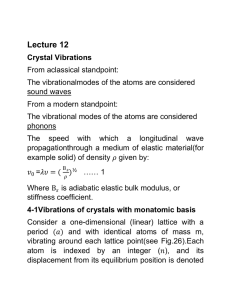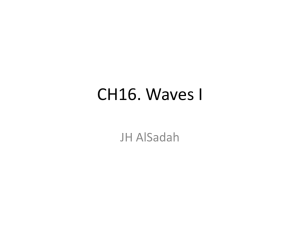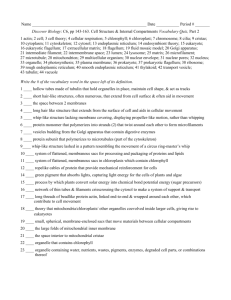wave propagation along flagella - damtp
advertisement
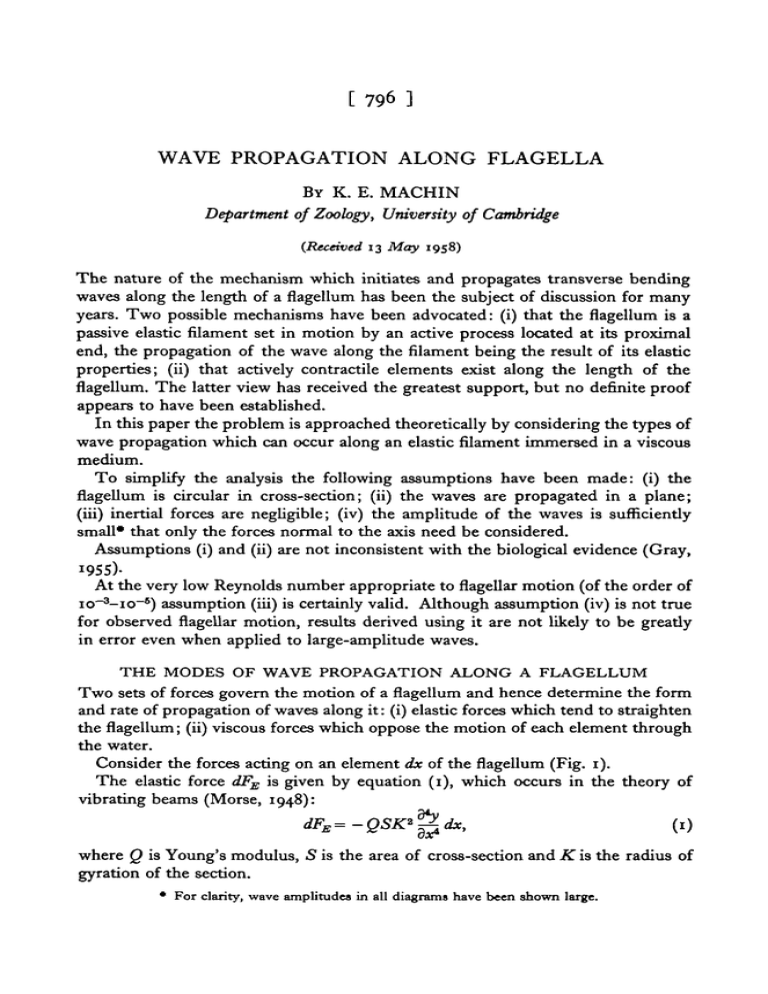
[796]
WAVE PROPAGATION ALONG FLAGELLA
BY K. E. MACHIN
Department of Zoology, University of Cambridge
{Received 13 May 1958)
The nature of the mechanism which initiates and propagates transverse bending
waves along the length of a flagellum has been the subject of discussion for many
years. Two possible mechanisms have been advocated: (i) that the flagellum is a
passive elastic filament set in motion by an active process located at its proximal
end, the propagation of the wave along the filament being the result of its elastic
properties; (ii) that actively contractile elements exist along the length of the
flagellum. The latter view has received the greatest support, but no definite proof
appears to have been established.
In this paper the problem is approached theoretically by considering the types of
wave propagation which can occur along an elastic filament immersed in a viscous
medium.
To simplify the analysis the following assumptions have been made: (i) the
flagellum is circular in cross-section; (ii) the waves are propagated in a plane;
(iii) inertial forces are negligible; (iv) the amplitude of the waves is sufficiently
small* that only the forces normal to the axis need be considered.
Assumptions (i) and (ii) are not inconsistent with the biological evidence (Gray,
1955)At the very low Reynolds number appropriate to flagellar motion (of the order of
I O ^ - I O " 6 ) assumption (iii) is certainly valid. Although assumption (iv) is not true
for observed flagellar motion, results derived using it are not likely to be greatly
in error even when applied to large-amplitude waves.
THE MODES OF WAVE PROPAGATION ALONG A FLAGELLUM
Two sets of forces govern the motion of a flagellum and hence determine the form
and rate of propagation of waves along it: (i) elastic forces which tend to straighten
the flagellum; (ii) viscous forces which oppose the motion of each element through
the water.
Consider the forces acting on an element dx of the flagellum (Fig. 1).
The elastic force dFE is given by equation (1), which occurs in the theory of
vibrating beams (Morse, 1948):
^dx,
(r)
where Q is Young's modulus, S is the area of cross-section and K is the radius of
gyration of the section.
• For clarity, wave amplitudes in all diagrams have been shown large.
Wave propagation along
flageUa
797
The viscous force dFv can be calculated from the formula for the drag of a
cylinder at low Reynolds numbers (Lamb, 1932):
\Tt\l.
(2)
2-0 — log R dt
where \i is the viscosity and R is the Reynolds number.
Strictly this relation is non-linear, since R is a function of dy/nt. At these very
low Reynolds numbers, however, the coefficient in (2) varies only slowly with R, and
may, without serious error, be considered constant over most of the cycle of
oscillatory movement. Only as the velocity approaches zero does this approximation break down, but here both dFE and dFr are approaching zero, so little error will
result
Fig. 1. Forces acting on an element of a flagellum.
Since dFE must equal dFv,
% dx,
y-logR dt
\TTJJ,
dx
1
(3)
dy
a
QSK 2-o-logRdt'
The steady-state solution of this differential equation can be shown to be
(5)
where/is the frequency of oscillation, rlt ra, r3, r4 are the four values ofty—i\
A, B, C, D are complex constants depending on the conditions at the two ends of the
flagellum and ^ is the ' scale length' given by
l(QSK*2-o-logR\
l(
(6)
Each of the four terms of equation (5) represents one of the four types of wave
(or 'modes') which can propagate along the elastic filament (Fig. 2). The relative
amplitude and phase of the modes depend on the conditions at the ends of the
798
K. E. MACHIN
filament. The characteristics of the four modes are given in Table i, where the
'damping distance* is the distance the wave travels before its amplitude falls to i/e
of its original value.
On an infinite unconstrained flagellum only the principal mode will exist. This
wave carries the flux of energy distally along the flagellum, the continuous loss of
energy along the length manifesting itself as a decrease in amplitude. Any lateral
constraint (e.g. a rigid hinge) at the proximal end will initiate the secondary mode.
If, in addition, theflagellumis of finite length, both principal and secondary modes
are reflected at the distal end to give modes III and IV.
II
IV
Fig. 3. Modes of wave propagation along a flagellum.
It is important to note that all wavelengths and damping distances are proportional to 1$, the scale length. This length depends on the frequency of oscillation,
the mechanical properties of the flagellum and the nature of the medium; it is the
only term in which these parameters enter into the wave equation. It thus follows
that the form of the waves propagated along a flagellum is independent of all these
parameters. Variation of stiffness, frequency, viscosity, etc., only affect the scale of
the waves.
Table i
Designation
of mode
I.
II.
III.
IV.
Principal
Secondary
Reflected principal
Reflected secondary
Direction of
propagation
Direction
in which
amplitude
decreases
Wavelength
Damping
distance
Increasing x
Decreasing x
Decreasing x
Increasing x
Increasing *
Increasing x
Decreasing x
Decreasing *
6-84,
i6sio
6-&o
16-5/,
3-62,
I-I/O
2-6/0
II/.
As mentioned earlier, the relative amplitudes of each of the four modes are
determined by end conditions. In the next section one specific set of proximal end
conditions will be imposed and the resultant wave-patterns computed.
Wave propagation along
flagella
799
THE FLAGELLUM DRIVEN BY ANGULAR OSCILLATION
OF THE PROXIMAL END
If the proximal end of a filament is constrained to move about a rigid hinge, and
the energy is fed in by angular displacement of the constrained end, the system
approximates to a flagellum attached to a stationary head. The boundary conditions
for all *,
(7)
are then:
y = o
at
x =o
^Ge
at * = o .
ox
Here G determines the amplitude of the motion.
At the distal end, both bending moment and shearing force vanish:
(8)
„,
If the total length of the flagellum is L, equations (5) and (y)-{io) give
y = GLe«*'ft+*li> (
-.
r - r ) x {sin 0 + sinh 6 + sin <* cosh (<f> - 0)
J
^
(2 + 2 cos <f> cosh <f>) l
T
\T J
— cos <f> sinh (0 — 0) —cosh <f> sin(^ — 0) + sinh <f> cos (0 —0)}, (11
where
0=y- (0-92-0-381)
and
<f> = T (0-92—0-381)
(12)
(13)
Wave-patterns have been computed from equation (11) for various values of L\
the results are shown in Fig. 3. Since distances are expressed in terms of 1$, these
patterns will represent the motion of any passive flagellum, whatever the values of
the physical parameters. In Fig. 3 the shape of the flagellum at successive intervals
of one-eighth of a complete cycle is displayed; the dotted line represents the envelope
of the motion.
DISCUSSION OF THE CALCULATED FLAGELLAR MOTIONS
The motion of the infinite flagellum constrained at its proximal end will be
considered first. Under such conditions the maximum amplitude occurs at about
i-21$ from the proximal end (Fig. 3 H). From this point onwards the principal wave
predominates; its amplitude decays exponentially, and is virtually zero at 10 IQ.
Irrespective of its length, the flagellum can exhibit only about invisible wavelengths.
When the flagellum is of finite length the reflected waves affect the resulting
wave-pattern, the amplitude of the distal end increasing with progressive shortening
of the length. When L = 2^ the amplitude of the free distal end is greater than that of
any other part of the flagellum; the envelope acquires a characteristic fish-like form
51
Exp. Blol. 35, 4
2l 0
I
3l 0 4l 0
I
I
Horizontal scale for A-H
l0
I
5l 0
I
Fig. 3. Calculated wave-patterns on a flagellum. Vertical amplitudes have been exaggerated for clarity.
0
1
1
Tapered
X
o
>
W
o
o
00
Wave propagation along
flageUa
801
but contains less than one wavelength. When L<il^ the motion approximates to
that of a relatively rigid cilium.
Two of the arguments purporting to show that distributed contractile elements
must exist along flagella are: (i) Since in observed flagellar motions the point of
maximum amplitude occurs some way from the proximal end, energy is being fed
in near this point; (ii) inertial forces are necessary to maintain a progressive wave
system. The results of Fig. 3, derived for a weightless passive flagellum, show that
these arguments are not valid.
However, it is clear from Fig. 3 that a passive elastic flagellum of uniform crosssection driven from one end cannot exhibit more than \\ wavelengths along its
length. Further, the amplitude of the wave decreases exponentially. If a flagellum
exhibits more than i\ wavelengths, or has a sustained amplitude along its length,
the propagation of the waves cannot be due to a passive mechanism. This conclusion is unaffected by the nature of the drive at the proximal end, since the
secondary wave becomes negligible beyond 3^.
So far only uniform flagella have been considered. The behaviour of a flagellum
whose size or mechanical properties vary along its length can readily be described,
provided that the variation is slow compared with the wavelength. Under these
conditions the value of 1$, the scale length, will vary along the flagellum, giving a
non-linear 'stretch' to the wave-patterns of Fig. 3. The result of this is shown in
Fig. 3 J drawn for a flagellum whose distal end is one-third of the diameter of the
proximal end. Again waves of sustained amplitude appear impossible.
So far as is known, the only instance in which the envelope of an actual flagellum
has the form of any of the curves of Fig. 3 is in the case of 'ageing' spermatozoa
described by Gray (1955). On the other hand, passive models described by Gray
(1955) have envelopes very similar to those of Fig. 3.
It appears, then, that under certain abnormal circumstances sperm tails behave
as though they were passive, but that to explain their normal motion an active
mechanism is essential.
BENDING MOMENTS IN AN ACTIVE FLAGELLUM
As it seems clear that the waves exhibited by a passive elastic filament cannot
resemble those observed on a normal flagellum, it is of interest to consider the
alternative hypothesis of actively bending elements distributed along the length of
the filament.
If a distribution B (x) of active bending moment along theflagellumis postulated,
equation (1) becomes
dF^-QSK&dx-^dx,
(14)
and (3) becomes
i
31-2
802
K. E. M A C H I N
This equation gives implicitly the form of B(x) corresponding to any specified
motion.
As an example the form of B(x) will be calculated for the case of a sine wave of
constant amplitude b and wavelength A propagating along the flagellum.
Putting
y
(18)
equation (16) gives
(20)
(21)
or
This represents a progressive wave of bending moment with a wavelength,
velocity and direction of propagation similar to the wave of displacement; there is,
however, a phase difference between the waves.
(a)
Fig. 4. Forces on a flagellum.
Equation (21) comprises two components, corresponding to the two terms
within the brackets. The first component is a progressive wave in phase with the
wave of displacement and represents the bending moment necessary to produce the
sinusoidal elastic deformation of the filament. The second component is a progressive wave in quadrature with the wave of displacement, being the bending
moment required to equalize the viscous forces on the filament. The origin of these
two components is illustrated in Fig. 4. In (a) the elastic forces tending to straighten
the filament are shown; it is clear that the maximum bending moment occurs at the
point of maximum displacement. The viscous forces shown in (b) produce a
maximum moment at the point where the displacement is zero.
Wave propagation along
flagella
803
The resultant total bending moment is the sum of the two components; if
elastic forces predominate, the resultant is nearly in phase with the displacement,
while if viscous forces predominate, the resultant approaches quadrature with the
displacement.
ENERGY CONSIDERATIONS FOR AN ACTIVE FLAGELLUM
Some of the energy fed into each element of the flagellum will be used to overcome viscous forces; the remainder is absorbed in elastic deformation of the element.
Unless a reversible mechanism exists to convert this elastic energy back into
chemical energy, it is irrecoverable and will degrade into heat in the elastic or contractile components. While there is some evidence for reversibility in vertebrate
muscle under special circumstances (Abbott, Aubert & Hill, 1951) it seems unlikely
that in the present case any appreciable fraction of the elastic energy will be
recovered.
On this assumption, the power expended in the flagellum can be shown to be
(22)
In this equation the first term represents the power used in overcoming viscous
forces, and the second the power required for the elastic deformation.
Taylor (1952) and Hancock (1953) have shown that for a small undulating
organism carrying waves of small amplitude the forward velocity v is given by
(23)
From (22) and (23)
PJL
For a given power P and frequency /, equation (24) gives a maximum value of
uwhen
,X\*
Substituting from equations (6), (18) and (19)
Comparison of this value with those given in Table 1 shows that for an active
flagellum the maximum propulsive efficiency (i.e. maximum forward speed for
a given power) is attained when the wavelength of the actively generated wave is
very nearly the same as that of the principal wave on a passive flagellum.
At the condition for maximum efficiency it can be shown from equation (22)
that one-quarter of the power is used for elastic deformation, the remainder being
dissipated by viscous forces. Furthermore, from equation (21) it can be shown that
the real and imaginary components of the wave of bending moment are very nearly
804
K. E. M A C H I N
equal. This indicates that the progressive wave of bending moment leads the wave
of displacement by about one-eighth of a complete cycle.
For a wavelength other than the optimum, the phase difference between the
waves of bending moment and displacement will lie between o and \TT.
THE ACTIVATION OF CONTRACTILE ELEMENTS
A flagellum can be idealized into an elastic filament surrounded by or enclosing a
series of bilaterally arranged contractile elements, differential contraction of elements
on the two sides producing localized bending moments (Fig. 5). The relation
between the tension and length of the elements and the displacement and bending
moment of the flagellum is given in Table 2, where A and B refer to the elements
on the opposite sides (Fig. 5).
Fig. 5. Contractile elements surrounding an elastic filament.
Table 2
B
A
Tension
Bending moment
Tension
Bending moment
High
Low
Negative
Positive
High
Low
Positive
Negative
Length
Displacement
Length
Displacement
Long
Short
Positive
Negative
Long
Short
Negative
Positive
It was shown earlier that for maximum propulsive efficiency the wave of active
bending moment leads the wave of displacement by about \TT. From Table 2 it will
be seen that for both elements A and B this implies that the tension should lag
on the length by about £77. The phase relations for the two elements are shown in
Fig. 6.
Pringle (1957) has suggested that the rhythmic activity of a spermatazoon might
arise from a myogenic mechanism; this suggestion will now be examined in the
light of the present results. In studies of insect fibrillar muscle, Boettiger, Machin &
Pringle (1958) have shown that these muscles behave like a combination of two
components: (i) an ordinary visco-elastic element and (ii) an elastic element in
Wave propagation along
flagella
805
which the force due to a change of length only appears after a time delay of the
order of a few milliseconds. In the muscles studied, the ordinary elasticity was
rather larger than the 'delayed elasticity'; for sinusoidal movements a phase lag of
only about \IT between length and force could occur. It is of course somewhat
speculative to relate this result to the minute contractile elements of a flagellum.
It seems, however, not unreasonable to postulate that such a delayed elastic effect
could predominate in these contractile elements; a phase lag of JTT between force
and length might then be sustained.
Bending moment,
tension
Displacement
Tension
Element A
Element 8
Fig. 6. Phase relationships for contractile elements.
In this way actively induced bending at the proximal end of a flagellum could
give rise to a propagated wave whose amplitude was sustained by energy arising in
the more distal elements. These elements would be activated when deformed by
a passively propagated wave of bending from the immediately proximal region.
No mechanism for the transmission of control information to the contractile
elements would be necessary.
Such a system could account for the following observed phenomena: (i) a flagellum
is motionless when separated from the middle piece of the spermatazoon or from
the basal granule (Gray, 1955); (ii) a small obstruction causes the more distal region
of the flagellum to become motionless (Gray, 1955)—further experiments on this
effect would be valuable; (iii) while fresh spermatazoa show sustained amplitude
along all their length, ageing sperms have an envelope similar to those drawn in
Fig. 3 for passive filaments (Gray, 1955). It is postulated that as the sperms age the
contractile elements in the tail become inactive, although the oscillatory bending
at the proximal end continues.
QUANTITATIVE COMPARISON WITH OBSERVATION
As already shown, for maximum propulsive efficiency the wavelength on an active
flagellum must be of the order of 6^. The value of ^ the scale length, is given by
equation (6). Using the parameters given by Gray (1955) and Gray & Hancock (1955)
806
K. E. M A C H I N
for the spermatozoa of Psammecfunus mHaris the value of ^ is i-8/x, corresponding
to a wavelength for maximum efficiency of 12/x; the observed value is 24/14. In
view of the approximate nature of the theory and of the value of Young's modulus
employed, the prediction of the wavelength to within a factor of two is satisfactory.
SUMMARY
1. The types of bending waves which can propagate along a thin elastic filament
immersed in a viscous medium are derived.
2. It is not possible to account for the form of the waves observed on actual
flagella if the flagellum is regarded merely as a passive elastic filament driven from
its proximal end.
3. The observed wave forms can be explained by assuming active contractile
elements distributed along the length of the flagellum. These elements could be
activated by local bending.
I wish to thank Prof. Sir James Gray for introducing me to the problem, and for
his continued help and advice. I am also indebted to Lord Rothschild for valuable
criticism and to Elisabeth Machin for assistance with the mathematical aspects of
the work.
REFERENCES
ABBOTT, B. C , AUBERT, X. M. & HILL, A. V. (1951)- The absorption of work by a muscle stretched
during a single twitch or tetanus. Proc. Roy. Soc. B, 139, 86-104.
BOETTIGBR, E. J., MACHIN, K. E. & PRTNGLE, J. W. S. (1958). Fibrillar muscle. Proc. XV Int. Conf.
Zool. (in the Press).
GRAY, J. (1955). The movement of sea-urchin spermatazoa. J. Exp. Biol. 3a, 775-801.
GRAY, J. & HANCOCK, G. J. (1935)- The propulsion of sea-urchin spermatozoa. J. Exp. Biol. 32,
802-14.
HANCOCK, G. J. (1955). The self-propulsion of microscopic organisms through liquids. Proc. Roy.
Soc. A, 317, 96-121.
LAMB, H. (1932). Hydrodynamics, p. 616. Cambridge University Press.
MORSE, P. M. (1948). Vibration and Sound, p. 154. New York: McGraw Hill.
PRTNOLE, J. W. S. (1957). Myogenic Rhythms. In Recent Advances in Invertebrate Physiology,
pp. 99-115. Oregon: University of Oregon Publications.
TAYLOR, G. I. (1952). The action of waving cylindrical tails in propelling microscopic organisms.
Proc. Roy. Soc. A, a n , 225-39.

